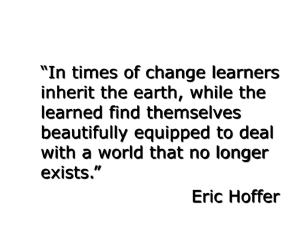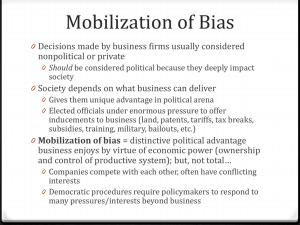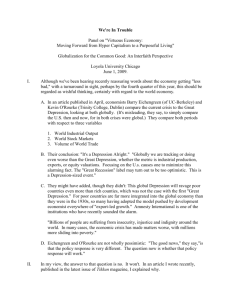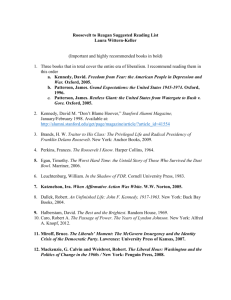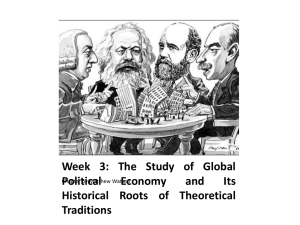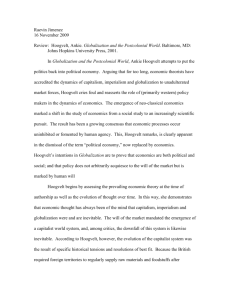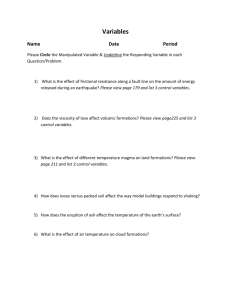Katznelso_Zolberg
advertisement
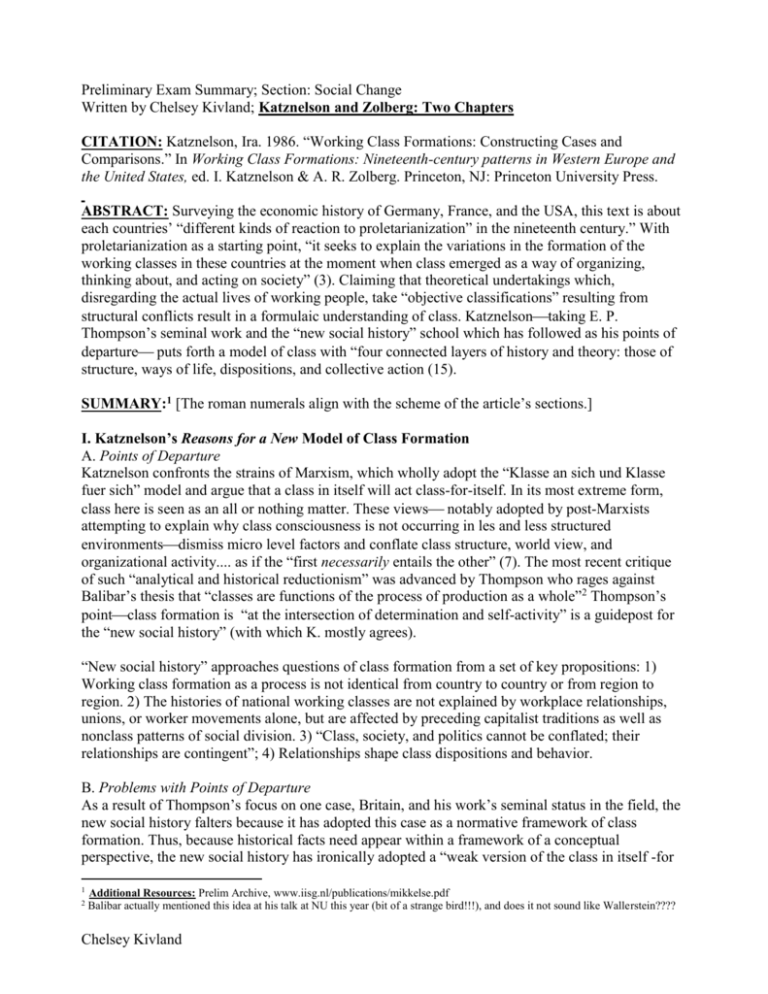
Preliminary Exam Summary; Section: Social Change Written by Chelsey Kivland; Katznelson and Zolberg: Two Chapters CITATION: Katznelson, Ira. 1986. “Working Class Formations: Constructing Cases and Comparisons.” In Working Class Formations: Nineteenth-century patterns in Western Europe and the United States, ed. I. Katznelson & A. R. Zolberg. Princeton, NJ: Princeton University Press. ABSTRACT: Surveying the economic history of Germany, France, and the USA, this text is about each countries’ “different kinds of reaction to proletarianization” in the nineteenth century.” With proletarianization as a starting point, “it seeks to explain the variations in the formation of the working classes in these countries at the moment when class emerged as a way of organizing, thinking about, and acting on society” (3). Claiming that theoretical undertakings which, disregarding the actual lives of working people, take “objective classifications” resulting from structural conflicts result in a formulaic understanding of class. Katznelsontaking E. P. Thompson’s seminal work and the “new social history” school which has followed as his points of departure puts forth a model of class with “four connected layers of history and theory: those of structure, ways of life, dispositions, and collective action (15). SUMMARY:1 [The roman numerals align with the scheme of the article’s sections.] I. Katznelson’s Reasons for a New Model of Class Formation A. Points of Departure Katznelson confronts the strains of Marxism, which wholly adopt the “Klasse an sich und Klasse fuer sich” model and argue that a class in itself will act class-for-itself. In its most extreme form, class here is seen as an all or nothing matter. These views notably adopted by post-Marxists attempting to explain why class consciousness is not occurring in les and less structured environmentsdismiss micro level factors and conflate class structure, world view, and organizational activity.... as if the “first necessarily entails the other” (7). The most recent critique of such “analytical and historical reductionism” was advanced by Thompson who rages against Balibar’s thesis that “classes are functions of the process of production as a whole”2 Thompson’s pointclass formation is “at the intersection of determination and self-activity” is a guidepost for the “new social history” (with which K. mostly agrees). “New social history” approaches questions of class formation from a set of key propositions: 1) Working class formation as a process is not identical from country to country or from region to region. 2) The histories of national working classes are not explained by workplace relationships, unions, or worker movements alone, but are affected by preceding capitalist traditions as well as nonclass patterns of social division. 3) “Class, society, and politics cannot be conflated; their relationships are contingent”; 4) Relationships shape class dispositions and behavior. B. Problems with Points of Departure As a result of Thompson’s focus on one case, Britain, and his work’s seminal status in the field, the new social history falters because it has adopted this case as a normative framework of class formation. Thus, because historical facts need appear within a framework of a conceptual perspective, the new social history has ironically adopted a “weak version of the class in itself -for 1 2 Additional Resources: Prelim Archive, www.iisg.nl/publications/mikkelse.pdf Balibar actually mentioned this idea at his talk at NU this year (bit of a strange bird!!!), and does it not sound like Wallerstein???? Chelsey Kivland itself model” as a hidden tool to order empirical facts generated by a study of the working class. “Although Thompson’s approach “fits” the English case, it inhibits comparative analysis because it takes for granted that which elsewhere needs to be explained” (11). Class needs to be examined in context before situated class formation can be understood. Second, because Thompson defines class as a relatively self-conscious group, “willing and capable” to affect itself, the absence of such formations are treated as deviant. Third, Katznelson argues against the polarization in Thompson’s argument of theory and history. Where Thompson views theory as a tool to develop models of the situational logic whereby deviations can be marked, Katznelson claims, “theory should help us build on the insight” of history (13). He states that not only shall we address what Tilly makes clearhow concrete huge comparisons can help us understand large-scale processes, but we also need constructions of cases to make macrohistorical comparisons. II. Katznelson’s Model of Class Formation To bridge theory and history in class formation, Katznelson sees classits definition and application as a starting point. He suggests “class be thought of as a concept with four connected layers of history and theory: those of structure, ways of life, dispositions, and collective action (15). This is an attempt to “provide tools to construct cases of class formation systematically in order to promote comparative historical analysis” (14). In short, class needs to be clearly defined before it can be rightly interpreted. A. Structure The first level is the structure of capitalist development, including the elements of the economy, i.e., of privately owned autonomous firms that seek to make profit. Common to all societies, capitalism is impossible without proletarianization and a “quite specific form of exploitation” (14). At this level, class is an analytical construct that is “experience-distant” and used to analyze the motion of capitalist development. But, “family patterns, demography, cultural traditions, inherited practices, state organization…” determine the contours of the macroscopic economic development (15). Enter the following: B. Ways of Life The level of ways of life considers how actual capitalist societies develop at work and away from it (16), “Experience-near,” this level assesses the variations of how capitalism has developed in different contexts, namely how individuals and collectivities have enacted capitalism in real social formations. Thus, both at home and at work class relations are lived and experienced. Level 1 and 2 are closely related, yet distinct entities, but at both levels it is possible to construct classifications of class relationsworkers’ positions and duties. This tells us how workers live and exist in certain circumstances, but not how they will think or act…enter following: C. Dispositions Neither heuristic devices nor typologies, the third level identifies classes as formed groups sharing dispositions. Katznelson avoids any reference to “class consciousness,” attempting to “map the terrain of lived experience and define the boundaries between the probable and improbable” (17). As Thompson sates, “When we speak of class we are thinking of a loosely-defined group…who have a disposition to behave as a class to define themselves in their actions, and in their consciousness in relation to other groups of people in class ways” (18). This level models a Geertzian frame of cultural analysis, whereby how people construct meaning to make their ways through the experienced world is most compelling because shared dispositions are interactive. Chelsey Kivland Dispositions are not coextensive with class structures and class-based ways of life; nor do they mirror reality…they are plausible and meaningful responses to the circumstances workers find themselves in” (19). But class is not a thing, it is a happening…enter following: D. Collective Action Workers sharing dispositions may or may not act on these motivational constructs to engage in collective action. Thus, the forth level distinguishes “classes that are organized and that act through movements and organizations to affect society” (20). Because class conflicts not necessarily entailed in the class organization of social action, collective action varies by nature and degree. ***The distinctions drawn can be read as an elaboration on Thompson’s junction term, for they allow specification on the “points of connection between the structure of class relations at the macroeconomic level; the lived experience of class in the workplace and in the residence community” (21). Class is a junction term “at the intersection of structure and process, social being and social consciousness” (20). “Structural change gives rise to changed experience: that is, both to a set of subjective perceptions and to a more active process of learning…[to act] to modify objective realities,” (21- from Thompson). The formations of the levels open the possibility of alternative kinds of inter/intra level relationships, whereby class formation may be thought of more comprehensively as concerned with the conditional process of connection between the levelsproviding a more elaborated and variable object for comparative historical analysis. III. National Variation and its Explanation When looking at how class formation emerged in different countries, Katznelson argues that culture, if we are prepared to see culture as webs of significance, is threaded by the webs spun by “working people suspended between the very hard and jagged economic, social, and political rocks” (22). Class behavior has a contingent relationship to changes in the structure of society and ways of life. Instead of asking whether class formation occurred, the concrete, historical analysis should proceed from the “specific, but deliberately open, object of analysis: the ways the newly emerging classes expressed their claims to their employers and to the state” (24). Katznelson has tried to arrive at a portrait of similarities and variations by looking at the three cases with the same lens. There is a lot of history here (which seems beyond the scope of the exam or beyond the scope of my patience), so main points of comparison for the three cases are: a) the significance and weight of “artisan values, culture, organization, and leadership; b) the degree of division or linkage through which workers pursued their interests in the workplace and in the realm of politics; c) manner of orientation toward integration with the state and society and in the “concomitant levels of militancy that they exhibited” in collective actions (29); d) the type of mix of local and national affiliations; e) relative importance of Marxist and socialist appeals (29), f) extent of hiatus between early and late nineteenth century patterns of class formation” (30). VI. Hypotheses To-Be-Developed [IV] Organized by country and by time, the hypotheses developed in this text “help to explain each country’s exceptional history of class formation in three broad clusters”: A. Economy-Centered: Internal analysis of capitalist and class development, i.e., effects of variations in basic dynamics of economic change and patterns of work and labor markets on the history of the working class. Chelsey Kivland B. Society-Centered: Beyond the processes of capitalist development and proletarianization, B searches for the sources of variation in class formation, i.e., religion, demography, and special configurations. C. State-Centered: The most important marocausal focus is the state, which includes formation of the nation-state, impact of French revolution, character of state bureaucracy, capacity of the state to tax, conscript, make public, repress policy, constitutional questions, citizenship and franchise, content of public policies (31). **Of course, the divide if blurry between the focuses…each essay develops own specific causal analysis. RELEVANCE: This chapter seems particularly useful to argue how “patterns of sentiment, behavior, and organization” shaped and continue to shape class relations (3). Katznelson, in strongly advocating for analysis of social interaction within and among (self-conscious or non-self-conscious) classes, reinserts agency as a key variable in theory and research on class formation, relation, and development. Katznelson, as a champion of relativism, can also be utilized to support a countryspecific/culture-specific analysis (non-Wallerstein, but still claims Marxist departure). He emphasizes the role of cultural factors as distinct defining variables, which enable a more full and variable conceptualization of class and, thus, class formation than structural analysis alone. Last, Katznelson’s model departs from the classical Marxist “Klasse an sich-Klasse fuer sich” model to argue “with the specification of different levels, it becomes possible to construct the various cases of class formation in their own terms and to explore their competing capacities of various macrohypotheses about linkages between the levels” (14). This is not non-Marxist, for it is rooted in concrete description and explanation, but is to be seen as an “improvement” upon the superstructure-basis model, for it introduces social and cultural variables to color the economic and political picture of class formation. Additional Notes: Chelsey Kivland CITATION: Zolberg, Aristide R. 1986. “How many exceptionalisms.” In Working Class Formations: Nineteenth-century patterns in Western Europe and the United States, ed. I. Katznelson & A. R. Zolberg. Princeton, NJ: Princeton University Press. ABSTRACT: Contesting the exceptionalist approach to studying working class formation, which “posits one national pattern as the theoretic norm in relation to which all others are treated as deviant cases,” Zolberg presents an alternative model whereby “each historical situation [is treated] as a case of working class formationthat is, as something akin to one of several possible states of a dependent variable and that can be accounted for by reference to variation among a set of factors considered,…as theoretically grounded independent variables (399, 401). In analysis of the four (UK, US, G, F) cases, Zolberg argues that the variation can largely be accounted for by the “shape of industrial capitalism”, and moreover, the character of the state regime. There is not a norm and many deviant, but as many “exceptionalisms”3 as cases under consideration. SUMMARY:4 I. Exceptionalism: Its Problems and Zolberg’s Model: Its Contribution (397) The main problem with exceptionalism is that it exaggerates the similarities between certain countries and the differences between this group and “so termed” exceptional cases. Although the forms of collective action bore a strong family resemblance across nations, they also exhibit considerable cross-national variation in strike frequency, union outlook, and organizational characteristics. Partially because at the turn of the century workers came closer than ever to sharing a common political doctrine (Second International), this exceptionalist norm of study is deeply anchored in the field. In fact, the success of the idea that socialism, inspired by Marxist doctrine, is the “normal outcome” of working class formation is attributed to the success of the German Socialists; one could, given the evidence, have just as easily discerned that craft unions would be the main influence under advanced capitalism. With the problems with the “exceptionalist” model as stated, the opposing approach is to look at each country as though its class characteristics are independently and internally shaped. This latter approach negates how world patterns determined the dynamics of class development and structure in order to disregard all framing ideologies. Thus, the “exceptionalist” tradition and the “end of ideology” approach are so bound up in ideological controversy that they have outlived their usefulness. A way out of the dilemma is to utilize a generic method, which takes each historical case as a dependent variablewith an array of possibilitiesto explain its character via the influence of a set of independent variables. Though, Zolberg seeks not to achieve statistical generalizations, but to enhance understanding by systematizing the observation of cross-national commonalities and variations, eliminating “unique” interpretations, identifying the combination of factors, and accounting for the fact that structural features only name the range of possibilities within which actual outcomes resulted from constant strategic interactions” (401). Historical Outcomes as Dependent Variables Zolberg argues that in order to make cross-national comparison possible and maximize theoretical returns, one needs precise identification of what needs to be explained. Most of the literature, 3 4 See Title Additional resources: Prelim Archive Chelsey Kivland however, has devised explanations with remarkably little logically prior requirements. Such practice highlights four distinct conceptual weaknesses in the field: 1) An anachronistic retrojection into the early twentieth century of variations in the outcome that surfaced only after WWI, Russian revolution, Great Depression, and other awesome historical events; 2) A lack of specificity with respect to the time frame of the relevant outcome, esp. where the state of affairs changed significantly over time- i.e., in Ger and Fr; 3) A conflation of class 3 (dispositions) and class 4 (collective action), which makes impossible exploration between these two levels; 4) A drastic reduction of the considerable variety found at the levels of class 3 and 4 to a “modal” pattern of relationships to the market or political arena and then unproductively assigned a single location on a unilinear continuum (403). Such conceptual problematics impinge on research. This is exemplified in the qualifications placed on countries’ movements, e.g., US seen as “moderate” and French seen as “radical”...which is most often illogically named as a result of the level of influence of the Communist party. II. Comparative Perspective of the Four Cases (1914- ) (408) Attempting to pay specific attention to the principal dimensions of variation with respect to class 3 and 4 in relation to the marketplace and political arena, this section will review in deliberately comparative perspective working class formation in the four cases in 1914. The emphasis is on problems of historical interpretation that are inherent to any macroanalytic comparative undertaking. Germany The German pattern distinguishes itself by the precocious and widespread sharing by workers of a class interpretation of social reality and the extensive mobilization of nearly the entire working class (exclude Catholics) into a single organizational world including party and unions, and their linked network of ancillary bodies. The party system was more organized than in other countries where there was universal suffrage for men. The German case presents the strange spectacle of considerable organizational strength, founded on a degree of mobilization approaching saturation, combined with political impotence (409). To explain, a very large proportion of Germans were organized under the Social Democratshaving an awareness of class and network for mobilizationbut were unable to enact their agenda against the strength of the imperial state of Germany. Without the war, the organization would likely have continued its path of transformation from a revolutionary movement to a mediating organization within capitalism, institutionalizing working class’ apparatuses within the politico-economic system. Great Britain Because the British did not support a communist party, which emerged elsewhere on the continent, most literature emphasizes this difference. The popular explanation, however, of the British moderate dispositions comes from the new model of trade unions; it seems to contradict the fact that British electoral alignments were also strongly influenced by class. Rather, a better explanation is provided by distinguishing dispositions from collective action, which, as such, makes clear the likelihood of strong class awareness within a world of organizations that have no commitment to class struggle. Unions may have eventually supported formation of a class-based party, but this was a practical response to the party leaders desire to act in the political arena, and not an incorporation Chelsey Kivland of class politics as their central aim. “This strange combination of widespread and acute class sentiment and often militant fervor with organizations” committed to the change within the capitalist system “is the most distinctive feature of the British pattern of the working class” (413). Class conflict, promulgated by the Labour party, came to be formally institutionalized in the political arena without jeopardizing the regime. France Allowing greater latitude of interpretation, most accounts of the French working class formation “emphasize the emergence of the CGT, a nation-wide federation of unions whose official doctrine was revolutionary syndicalism, as its most characteristic outcome” (418). Although from this viewpoint, the French are seen as having high class awareness, it is also the case that there was low membership and a normative moderate stance among members. Other problems arise form the disjuncture between working-class activity in the marketplace and in the political arena and the high level of change preceding WWI. It was so coined “a cause without rebels” (418). There were two forms of working class formation: 1) syndicates which as producer cooperative dealt with ongoing demands of the working class, 2) bourses which was a free association of producers (labor exchange to be seen as employment market) that educated and trained the proletariat. The unified socialist party rose to prominence, doubling from 1906-1914, and in 1914 an independent socialist legislated the income tax. United States Exaggerating the militancy and revolutionary dispositions of the French and German cases, there has been an opposing tendency to exaggerate the conservatism of the American case by “viewing the policies espoused by the AFL era as indicative of the outlook of workers and anachronistically projecting into the pre-WWI epoch orientations which owed a great deal to later developments” (426). Lack of interest in revolution did, in fact, not mean lack of militancy. As well, there was high union membership and a high incidence of Socialist tendencies, the latter of which was squelched by the Democrats strategic pandering to worker whims. Considered in the context that American workers did share a sense of class founded on their role as laborers, “the fact that only a minority of them acted within the political arena” identifies the most distinctive feature of the American outcome: “the orientation of workers qua citizens overwhelmingly toward the political mainstream. Thus, by opposing the war, American socialists were cast as doubly deviant from American mainstream and European fellows, and entered a marginal minority, whereas the AFL, in support of the war, joined the patriotic consensus and politically moderated their labor aims. III. Role of Economic and Political Structures With a better understanding of what needs to be explained, the contributions of economic and political structures to working class formation will now be explored by considering them as distinct independent variables. Zolberg emphasizes that economic organization has influenced patterns of social stratification, which in turn contributed to political formation. Likewise, political formations have played an important role in patterning economic structures. Note as well, that regional as well as country variation need be explained. The Disparate Incarnations of Industrial Capitalism Asking if capitalism matters, most sociologists answer, “No,” for greater weight is attributed to variations in the character of the state and economic structures. On the other hand, there is also classical Marxist interpretation in which industrial capitalism appears as a universal, rendering all societies very much alike. Chelsey Kivland An examination of the relevant literature suggests that the national configuration ought to be conceptualized as: a) the timing and pace of industrialization, b) the structure of the economy (433). The latter includes the extent of industrialization, the degree to which the individual sector is capital intensive, and the mechanism for the procurement of an industrial labor force (433). Z outlines that the commonly evoked propositions of class formation is timing and pace of industrialization. This has not been a convincing explanation of working class dynamics, whether in terms of qualitative measurement (sluggish/rapid) or GDP. Another problem has been the propositional focus on the extent of capitalist development as though a summation of uniform “stages of growth” structurally similar across nations. This assumes a monolithic capitalism that negates the diverse modes of capitalist development and how this influences working class formation. The extenuating variables in the US of rapid growth, land availability, high capital intensity and productive industry, a white collar sector, and immigration highlight Katznelson’s point of distinction between workers role as laborer and role as residentwhich is worth investigating on a comparative basis. The Political Regime as a Conceptual Variable The two major approaches of how to conceptualize class formation variations resulting from political influence: to focus on the character of the state (expressed as a dichotomous variable of strength or weakness) or to focus on the character of the regime more generally (the society’s constitution, expressed as a combined variation along two dimensions, extent of liberalism and political participation). “Stateness” entails two variables, one pertaining to centralization and the other to industrial variation of legal and administrative structures. Calling on the empirical record, Z states that it indicates a single generic process: “Wherever a state has historically emerged as a highly differentiated political actorthat is, where a monarchy achieved in attaining absolutismand managed to survive as such into the period of industrial revolution, liberalization did not lead to a sharp separation of politics and economics”… along mutually exclusive lines as occurred in Britain and especially the US (448). “Conversely, the combination of a sharp separation between the institutional spheres of politics and economicsthat is, between the private and public sectorswith institutional decentralization and diffuse political power (as in US) would tend to result in narrowly focused working class organizations and a tendency to confine their action to the appropriate institutional sector (449). The single most important fact, as supported by Lipset and the essays in the book, in shaping class formation is, “combining class 3 and 4…, “simply whether at the time this class was brought into being by the development of capitalism it faced an absolutist or a liberal state” (450). RELEVANCE: Zolberg should be read as a support for Katznelson’s argument to distinguish levels of classes when analyzing class formation. The evidence of national variation, as affected and affecting social and political organization, indicates that a unifying structural analysis simplifies the complexity of how class is formed and enacted in site and time-specific contexts. The chapter also highlights the need to look at cases, not normative generalities or peculiar outliers, when assessing the intersections of economic, social, and political influence on working class formation. Conceived here as a fairly internal variable, the state occupies considerable weight, indicating how analysis of the economy Chelsey Kivland shall extend beyond the market. But, I would contest the idea that the state can be analyzed apart from its position internationally, and that here local variation may continue where structural similarity exists. And, as I believe more reading will show, there is much relevance to be had for political influence of class-based social movements analyzed from a historical case-based model of multiple independent variable weights on the dependent variables of class formation’s form and degree. Additional Notes: Chelsey Kivland
